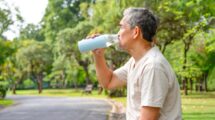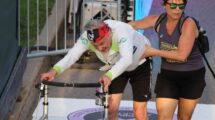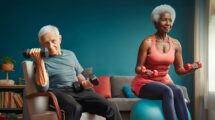When it comes to stroke, aging is a powerful risk factor.
By Peggy Edwards | March/April 2019
 February will always be “heart month” for me — time for valentines and love, and for thinking about heart health.This year I am moved to share the findings from Heart & Stroke’s 2018 Stroke Report: Lives disrupted: The impact of stroke on women. It is a groundbreaking report that provides some little- known facts about women, stroke and aging.
February will always be “heart month” for me — time for valentines and love, and for thinking about heart health.This year I am moved to share the findings from Heart & Stroke’s 2018 Stroke Report: Lives disrupted: The impact of stroke on women. It is a groundbreaking report that provides some little- known facts about women, stroke and aging.
Here are some of the findings in the 2018 Stroke Report:
- One-third more women die of stroke than men in Canada.
- Women are 60 per cent less likely to regain their independence.
- The risks of dying after stroke are significantly higher for those who were never married, remarried, divorced, or widowed than for those who have been continuously married, and a higher quality marriage increases survival.
- At the same time, there is a higher risk of marriage break-up if it is the woman who has the stroke.
- Women are less likely to go home after stroke; almost twice as many women as men go to long- term care instead.
- Less than half of stroke survivors who participate in rehabilitation are women (46 per cent).
- Older women are particularly over-burdened by stroke and are missing out on access to treatment, care and rehabilitation.
What is a stroke?
A stroke happens when blood stops flowing to any part of the brain. Strokes can be large or small, and the effects of stroke depend on the part of the brain affected and the extent of damage.
• Ischemic stroke is the most common form of stroke, caused by a blood clot.
• Hemorrhagic stroke occurs when a blood vessel ruptures, causing bleeding in or around the brain.
• A transient ischemic attack (TIA), sometimes referred to as a mini-stroke, is caused by a small clot that briefly blocks an artery and stops blood flow. TIAs are an important warning that a more serious stroke may occur.
Strokes can happen to anyone at any age,and vary in severity, type, cause and effect. But age is a risk factor for having a stroke and the chance of dying from stroke increases with age. Older women are exceptionally touched by stroke. They are the most likely to have a stroke, their strokes are the most severe, their outcomes are the poorest and stroke can put an end to their independence.
Older women may be frailer than older men and are likely to have other health problems, which makes their care more complicated in hospital, during rehabilitation, and once they are discharged. They do not always benefit equally from treatment and care, and they are under-supported in their recoveries with fewer opportunities for rehabilitation. An analysis by Heart & Stroke found that fewer older women were cared for on stroke units, which are best equipped to provide stroke care, compared with men and younger women. Over 25 per cent more women than men admitted to hospital with stroke are referred to palliative (end-of-life) care than men, further emphasizing that women have worse outcomes.
Many older women are under-aware of the signs of stroke and their personal risk factors. This concern is exacerbated by new research showing that women may present with different symptoms from men when they have a TIA (mini-stroke). This may lead to a missed diagnosis.
Women, particularly older women, are also under-represented in stroke research. We are only beginning to understand the differences between the brain health of women and men and to address them in ways that will improve the impact of stroke on older women.
“Women are less likely to return home and live on their own again after a stroke compared to men,” says stroke expert Dr.Anita Mountain. “This is not because men make more functional gains but because they are more likely to have a caregiver such as a spouse at home. This is very significant because the main goal for most people following stroke rehabilitation is to be able to go home.” A 2018 Heart & Stroke poll confirms this: over half of men (55 per cent) but less than half of women (47 per cent) say their spouse would care for them after they had a stroke. The poll also showed that women’s biggest worry after a stroke is to lose their mobility and independence and not be able to live on their own anymore.
Because stroke happens abruptly, family members — most often women — face a steep learning curve in a caregiving role. Women caregivers tend to deal well with physical deficits in their partners. They have more difficulty with emotional or behavioural issues and generally express the need for respite when faced with these situations. Male caregivers are more likely to look for practical, outside help — such as hiring someone to help with housekeeping and meals or finding programs to take their partner to for the day. Increasingly, adult children (usually daughters) are becoming caregivers for a parent who experiences a stroke. This can lead to ‘role overload’ and exhaustion as they juggle other responsibilities such as employment and parenting.
Women’s caregiving roles will continue to increase as the Canadian population ages and care burden shifts away from overcrowded hospitals. Unfortunately, women caregivers may ignore their own health to care for others and experience more stress and lower well-being. Although caregiving can be a positive experience in many ways, ironically, older women caring for a stroke survivor may be putting themselves at higher risk for having a stroke or other major health problem.
What can we do?
What can we as individuals and as a community do to minimize the occurrence and effects of stroke?
- Know and manage your stroke risk factors. Take the Heart & Stroke Risk Assessment at heartandstroke.ca/risk.
- Prevent stroke with healthy habits: eat a healthy diet, stay active, reduce stress and maintain a healthy weight. Work with your health care providers to manage medical conditions that increase risk, including high blood pressure, high cholesterol, diabetes, atrial fibrillation (irregular heart rhythm) and sleep apnea.
- Recognize the signs of stroke and act FAST!
- Face: is it drooping?
- Arms: can you raise both?
- Speech: is it slurred or jumbled?
- Time: to call 9-1-1 right away.
Stroke is a medical emergency. If you or someone else experiences any of these signs, call 9-1-1. Do not drive to the hospital. An ambulance will get you to the best hospital for stroke care. Getting to a hospital rapidly will more likely lead to a better recovery.
Be an advocate for yourself and others: ask questions of your healthcare provider and learn about your personal risk. Advocate for increased research on older women and heart health/stroke, more support for caregivers, homecare services, and better access to affordable medicines and stroke rehabilitation programs for women.
If you experience heart disease or stroke, or are caring for someone who does, connecting with other people who know what you are going through can help the recovery journey. Participate in peer-to-peer networking and support groups. Join the Heart & Stroke Community of Survivors and/or the Community of Care Partners. To register, go to heartandstroke.ca/connect.
To see the full 2018 Stroke Report, go






